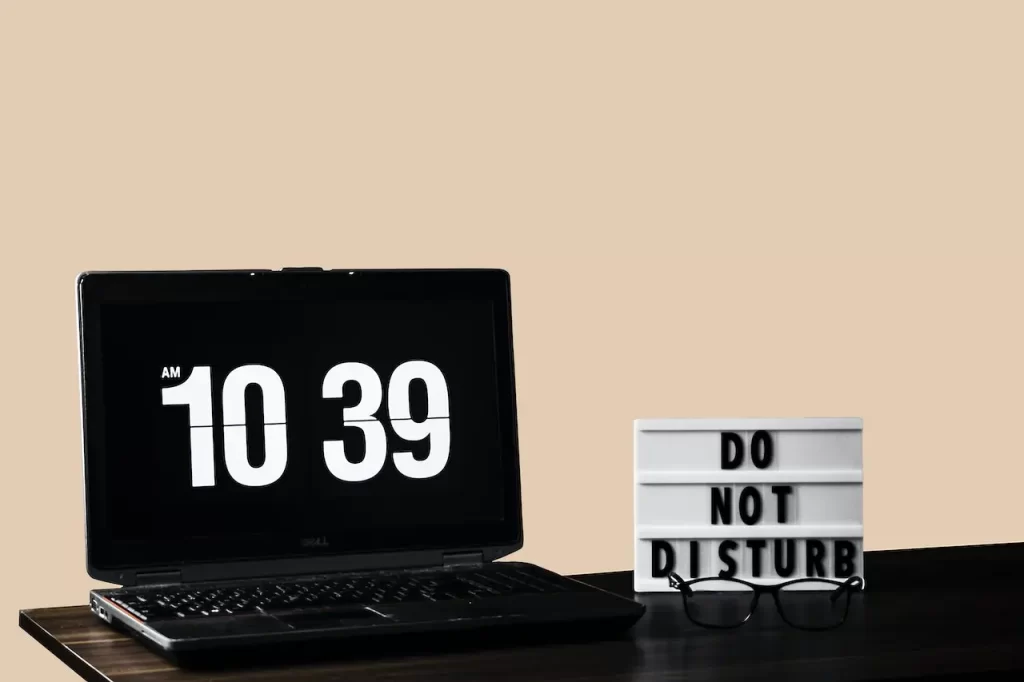
While it doesn’t sound fun, managing distractions, in terms of managing other people, is a key component of living a productive lifestyle. It is essential to time management, and almost inevitable (even if you travel a lot) – unless you never work with other people or have other people around you.
Managing other people is a key aspect of your remote work setup; you have to take that into account while setting up your entire remote working environment.
In this article, we are just talking about people who live in the same space as you, such as your family members or flatmates. Not only can they annoyingly interrupt your work, but they also may not play by your rules, especially if you have not properly set up your work-from-home boundaries and standards.
How to Eliminate Family Interruptions while Working from Home
There are many levels of things you can do to minimize getting distracted by family members.
Here is a list of items that will help reduce interruptions when you are working from home:
- Communicate with your family members
- Put up a “busy” sign on your door
- Start your day before everyone else is awake
- Maintain consistency in setting personal boundaries
- Have more flexible work hours
- Set up a dedicated workspace in a spare room
- Use noise-canceling headphones
- Use smart lighting to signal that you are busy
- Alternate between working at home and outside
- Move out or rent a place for work
Some items on this list are essential, while other items on this list are tactical and will make your life more efficient.
Let’s dive further into how to manage work-from-home interruptions in no-nonsense ways.
The basics of minimizing interruptions from family members
When getting interrupted by family members is a constant challenge, there are three non-negotiables of creating a distraction-free workspace: good communication with family members, consistency in implementing boundaries, and a dedicated distraction-free workspace.
Communicate with Family Members
Good communication is non-negotiable when you want your family members to respect your boundaries. You would likely neglect this because not many people would involve family members in setting up a distraction-free workspace. When you put in the effort to communicate your personal needs and schedules with family members, you are seeking their understanding and cooperation, thus involving them in producing a conducive environment for you.
It is easy to neglect the simple task of sharing our work schedules with our family members regularly.
This is important because simply saying “I need to work during the day” is vague. There are no boundaries being set up just by saying that.
Instead, think about communicating at least 2 of these 3 factors when it comes to your work: what, when, and how.
- Using a specific schedule during the week, let them know WHAT you will be working on, and HOW — do this to help them get a sense of the task’s importance, difficulty, or mission-critical nature.
- Let them know WHEN you will be doing such work, so that you will not be interrupted during this time.
- Then, free up dedicated times of the week when you would actually spend time together, and attempt to keep this commitment with your family members.
When you communicate in this way, your family members would know that you are unavailable on Monday morning at 11 am, when you are seated in front of the computer, or on Thursday afternoons during your business calls.
Besides telling your spouse, children, or parents what to do, let them take ownership in creating your distraction-free workspace.
In other words, you should set up your distraction-free system together with your family members. They will then respect your schedule.
One way to get others to listen to you – despite its irony – is to involve others in the decision-making process. Rather than telling your family members you need them to be quiet, introduce perspectives. Let them know the importance of your projects, and the space you need for productivity, and lead them towards forming the conclusions themselves. Because you have engaged them, they took part in the thinking process. As reasonable human beings, they will therefore develop some extent of investment and ownership in making your environment more distraction-free.
Another tip is to use a printed calendar with annotations on your schedule – share this with your family members. You can also use Google Calendar with your family members’ accounts synced so that you can view each others’ schedules. Communicate your schedule on a weekly basis (at least), or do it once every few days.
This article was originally published on unboundist.com. If it is now published on any other site, it was done without permission from the copyright owner.
Maintain your consistency
Now that you have set up good communication systems with your family, you need to be consistent about executing these systems.
This means that when you have shared your schedules with your family, keep to it.
Do not start socializing with family members at 3pm in the afternoon when you are meant to be having a business meeting. Even if you have spare time for entertainment, do it privately in your room.
If there are consequences to others violating your boundaries, execute those consequences. It could mean leaving the house, cutting down family time, or subtly ignoring someone for an entire afternoon by putting on noise-canceling headphones.
The point is to maintain consistency in implementing your personal boundaries and lifestyle structures. Then, your boundaries will be protected.
Set up a dedicated distraction-free workspace
You must set up a dedicated distraction-free workspace, and this point becomes paramount especially when you work in the presence of others. I have discussed at length how you can go about selecting the ideal location to set up your home office:
- Certainly, you should avoid family rooms and any common areas where family members hang out, unless it is the last resort.
- Locate your desk in a room away from people and noise such as the hallway, laundry room, gaming, or TV area.
- Work in a spare room or even your bedroom but you must get good at organization.
You could also set up environmental signals to show that you are busy. Of course, a simple way is to paste a sign at your door that says ‘Do not disturb’. However, this can be inconvenient, since you need to take it down and put it back up often.

If it suits your budget, you can use smart light bulbs in your room. When you plug a hue light bulb into a desk lamp and set it to a particular color, it can signal to others that you are busy working on something. You can vary the intensity of the color, or use different colors to show others the difficulty or type of task you are doing.
Another method to keep out the noise is to use active noise-canceling headphones. By listening to the sounds in your environment, noise-canceling headphones pick up these frequencies, and then create opposite sound waves to neutralize them. You may be surprised to find how effective they are in reducing unwanted ambient sounds. With such an addition to your work-from-home toolkit, it opens up the possibility of working in places that were previously too noisy and impractical to work in.
Further, you may want to consider soundproofing your room.
- Closing your door is obviously useful in keeping people and noise out.
- You can look into sealing gaps and openings in your walls, windows, and door.
- You may want to soundproof the air using white noise to drown out muffled voices that creep into your room.
Get rid of interruptions ruthlessly
If these solutions are too expensive for you, simply commit to switching between your home workspace and the nearby coffee shop or library throughout your week.
- Wake up early before the family rises, and work 2-3 hours as a head start.
- Then, head to the coffee shop once your home starts to get noisy.
- When you are tired, head back home and get in an extra 1-2 hours of ‘shallow’ work in the evenings.
Lastly, consider moving out and renting a place for work. This may sound extreme for some, and it is less practical if you need to manage children at home. But for others, renting a good small apartment (which is at least quiet) will eliminate the problems that you experience. You may not have to implement any other tactic listed in this article. If you do this, you do not need to work through the hassle of weekly communication and family improvised systems.
However, you would need some basics of financial planning – make sure you can cover your bills, have an emergency fund set up, and determine if you will share costs with a roommate if you were to rent a small apartment.